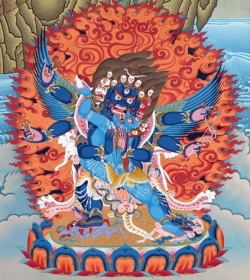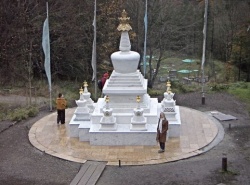The Namchak Putri, or The Meteoric Iron Razor teachings on Vajrakīlaya
Ritual meditations on the tantric deity, Vajrakīlaya (= Dorje Phurpa in Tibetan), constitute one of the major and central traditions of Vajrayāna practice, integrating all the nine vehicles of practice, and especially the three inner vehicles (yānas) of Mahāyoga, Anuyoga and Atiyoga. The generation of Vajrakīlaya comes from the Mahāyoga ("Great Yoga") teachings for transforming all experiences into an enlightened expression, and the conduct is in accordance with Mahāyoga. Vajrakīlaya is meditated on as the natural qualities of the nature of mind's illusory display, in accordance with the Anuyoga path. The View in Vajrakīlaya practice is the Atiyoga realisation, perfected as the unborn, unceasing, and unfabricated fruition.
The Vajrakīlaya tantras form one of the 18 principal Mahāyoga systems which were established early in the traditions of the Ancient Transmissions (snga 'gyur rnying ma) of Buddhist tantric teachings in Tibet. Moreover, Vajrakīlaya is one of the 8 main yidam deities for personal spiritual transformation (sgrub pa bka' brgyad), specifically, the yidam associated with enlightened activities. In practice, Vajrakīlaya has had the most vibrant spiritual tradition and been the most popular of all Nyingma tantric deities. Indeed, it is often said that Vajrakīlaya is the yidam of all the Nyingmapa. Many tantric lineages of Vajrakīlaya are still preserved. Each generation of masters continues to demonstrate their realisation, both in signs of meditative accomplishment, and in the masters' inspiring qualities, compassionately helping others to clear away their obstacles and to progress on the spiritual path.
As Kyabje Dudjom Rinpoche, emanation of Guru Padmasambhava, wrote in the full Ritual Manual for the Namchak Putri: "(Vajrakīlaya's) supreme and common siddhis [accomplishments] are bestowed with ease and the potency of (his) compassion is especially swift compared with other yidams. Thus, (he) is certainly the unique secret heart deity of all the accomplished vidyādharas [wisdom-holders] of India and Tibet." (Collected Works Volume Tha: p.80).
Vajrakīlaya is a wrathful form of Vajrasattva, the pure vajra nature of Enlightenment. In this imagery, the Compassion of the Buddhas is expressed forcefully, to eradicate in a powerful way the entrenched ignorance and emotional afflictions which cause obstacles, interfering with auspicious circumstances and preventing the dawning of realisation. Thus, the symbol of compassion is the phurpa or phurbu, the ritual dagger which stabs the obstacles and hostile forces of embodied ignorance, and transmits their consciousness to the Buddha fields. In the often repeated words of the root Kīlaya verses, "the Vajra Wrath cuts off hatred" (rdo rje khros pas zhe sdang gcod). The most negative and destructive emotional poison of hatred and aggression is utterly vanquished and transformed by the compassionate enlightened wrath of the deity, who is our own pure inner nature, unsullied by the turmoil of the emotional afflictions. Thus, this practice is similarly powerful in overcoming all the afflictions, of anger, delusion, jealousy, pride, passion, and so on. As well as being a supreme path for spiritual development, the practice of Vajrakīlaya is effective in pacifying social conflicts and disturbances, and also in mending breaches of the tantric samaya, such as the bonds between the community of Dharma practitioners.
Besides this deity's special spiritual qualities, Vajrakīlaya has become ubiquitous in Nyingma practice because he is famed as the chosen deity of Padmasambhava, the "Precious Guru," Guru Rinpoche, who is seen as the fount of the Ancient Transmissions in Tibet. In one account of the transmissions of the main tantric deities, the Khandro Lé-kyi Ong-mo (Las kyi dbang mo), Queen of Activities, also known as Dé-way khor-lo, Circle of Bliss, transmitted the eight sādhana cycles to the eight vidyādharas (wisdom-holders). She was a disciple of the deity, Vajrakumāra, the Vajra Youth, who is Vajrakīlaya himself. On this occasion, in the Cool Grove (Śītavana) charnel grounds, Guru Rinpoche specifically received the transmission for Vajrakīlaya, and after receiving empowerment, Khandro Lé-kyi Ong-mo bestowed upon him the name, Padmasambhava. He is said to have received the Vajrakīlaya teachings on other occasions from various other sources.
Another account tells of Padmasambhava collecting the Vajrakīlaya tantric collection of texts, called the Vidyottama la 'bum sde, and attaining accomplishment by practising Vajrakīlaya in Yang-le-shod (Nepal), and then transmitting this collection in Tibet. This account can be found in many texts, and recently, it was even found in a hand-written booklet which has been dated by modern scholarship to the late tenth century.
One recurring narrative in the literature on Padmasambhava and Vajrakīlaya is that he received the transmission from the Indian master, Prabhahasti, together with Vimalamitra and the Newari Śīlamañju. Each of the three then gained their own understanding which they combined into one authoritative cycle of Vajrakīlaya.
Not only are Guru Rinpoche and the Indian and Newari masters especially connected with Vajrakīlaya. Khandro Yeshe Tsogyal, famed in all the traditional accounts as the principal Tibetan student and consort of Guru Rinpoche, took Vajrakīlaya as her main yidam and attained enlightenment through this practice in Kurteo, Senge Dzong, Bhutan. Several of the other close students of Guru Rinpoche are similarly renowned for focusing on Vajrakīlaya and demonstrating the signs of meditative success as a result.
So important are the early Vajrakīlaya traditions that in the longest editions of the Ancient Tantra Collection (rNying ma'i rgyud 'bum), there are around seventy Vajrakīlaya texts, totalling nearly 4,000 pages. The Dudjom collection of the historically transmitted teachings (bKa' ma) has forty-eight Vajrakīlaya texts, totalling 2,692 pages. The spiritual potency of the early textual heritage also has resulted in key passages of sacred tantric liturgies which come from these texts being preserved and propagated within the continuing living tradition of Vajrakīlaya practice.
The Vajrakīlaya Treasure texts (gter ma) complement historically transmitted Vajrakīlaya tantras and commentarial texts. gTer mas, or scriptural revelations, provide a direct link between the celebrated group of Guru Rinpoche and his immediate disciples, with the master of the later generation who reveals the text. The revealer is considered a rebirth of one of the original circle of enlightened students, who has been destined to remember and recover the practice at the later time when it is most needed. Almost all of the many masters who have received scriptural revelations have revealed a Vajrakīlaya cycle, so the Treasure traditions have added a large number of further texts. A collection of Vajrakīlaya texts published by Zenkar Rinpoche in 2002 contains both the historically transmitted works and the revelations, and has over 1,200 texts in 41 volumes. Yet this collection includes only a representative selection of the vast literature on Vajrakīlaya.
Out of the many wonderful traditions of Vajrakīlaya, the Dudjom Namchak Putri (The Meteoric Iron Razor which Vanquishes Māra) is one of the most extensive and profound. It carries the full consecration of the practice lineage. It is a spiritually direct revelation of special potency today. It integrates sacred words from the root Vajrakīlaya tantras with key components of the principal Vajrakīlaya lineages, and enlightened scholarship of the Vajrakīlaya commentarial traditions.
The Dudjom Namchak Putri (gNam lcags spu gri) has developed from the revelation of Heruka Dudjom Lingpa, the first Dudjom Rinpoche (1835-1904). Heruka Dudjom Lingpa was an enlightened master who had visionary encounters with Guru Rinpoche and the wisdom deities from early childhood, and who trained in the traditions of Dudul Dorje (1615-1672). He was recognised as a rebirth of Khye'u-chung Lotsawa, one of the heart students of Guru Rinpoche, and he revealed many Treasure texts. His Vajrakīlaya revelation of the Sealed Secret Heart Practice (Thugs sgrub gsang ba rgya can), included in Volume Ca of his Collected Works, is part of his famous Profound Secret Dākinī Heart Essence (Zab gsang mkha' 'gro snying thig) cycle. This revelation became the core of the Dudjom Namchak Putri, as presented by Heruka Dudjom Lingpa's recognised rebirth, Terchen Chokyi Gyalpo (Great Treasure Revealer, King of the Dharma), Kyabje Dudjom Rinpoche, Jigdrel Yeshe Dorje (1904-1987). The name, Namchak Putri, derives from the revelations of Dudul Dorje.
Kyabje Dudjom Rinpoche, being the greatest terton in our time, received the Shokser (yellow scroll onto which a terton writes revelations) in his childhood. At the age of nineteen, he wrote commentaries on Dzogchen. He received his own Mind Treasures, including cycles covering all the three Roots of Vajrayāna, the Guru, the yidam deity, and the ḍākinī. Kyabje Dudjom Rinpoche's revelations are widely heralded for their depth of meaning and their concise formulation. With a lineage directly from Guru Rinpoche, they carry enormous consecrations and blessings. They are comprehensive in scope, with complete cycles on both the male and female aspects of the tantric tradition. At the same time, they are succinct, condensing the most essential points of the vast multi-volumed collections of the Vajrayāna teachings.
Kyabje Dudjom Rinpoche did intensive practice on and mastered Heruka Dudjom Lingpa's Vajrakīlaya, and in the course of this, he had his own Vajrakīlaya revelation. Furthermore, Kyabje Dudjom Rinpoche mastered many other Nyingma revelatory traditions, as well as becoming a renowned scholar of the scriptural and commentarial heritage. Elected Head of the Nyingma school during the time of greatest crisis for Tibetan Buddhism in the twentieth century, Kyabje Dudjom Rinpoche took on responsibilities for preserving, editing and developing the Nyingma scriptural and practice corpus of texts. This work included editing and composing fresh texts for many of the principal Vajrakīlaya traditions. Thus, in compiling the Dudjom Namchak Putri and making his own contributions to it, Kyabje Dudjom Rinpoche drew upon his vast enlightened scholarship and practice experience in the Vajrakīlaya traditions, as well as his own wisdom, and the vision of the original Treasure revelation. Kyabje Dudjom Rinpoche composed more than two volumes of texts for the Namchak Putri, the whole of Volumes Tha and Da of his Collected Works, as well as part of Volume Za.
The Dudjom Namchak Putri contains especially elaborate teachings on the Four Phurbu Transfixions (phur bu thal 'byin bzhi), which are the condensed essence of all Vajrakīlaya transmissions. The "Purely Aware Primordial Wisdom Phurbu" (rig pa ye shes kyi phur bu) is particularly developed in the Dzogchen section of the collection. The "Compassion Emanation Phurbu" (thugs rje sprul pa'i phur bu) is enlarged upon in the Ritual Manual and its long Commentary. Kyabje Dudjom Rinpoche is exceptionally renowned for his expansive treatment of the Generation Stage in this practice. The "Secret Bodhicitta Phurbu" (gsang ba byang sems phur bu) is addressed at length in the section on the yoga of the subtle channels and energies (rtsa rlung). These three Phurbu Transfixions are all focused on the Primary Ritual (stod las) for attaining Enlightenment. The final Phurbu Transfixion of the "Symbolic Material Phurbu" (mtshan ma rdzas kyi phur bu) is directed towards the liberation of hostile forces and obstacles, and is found in great detail in the Subsidiary Ritual (smad las) section of the collection.


